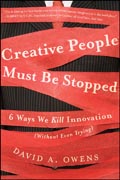
Creative people must be stopped: 6 ways we kill innovation (without even trying)
Owens, David A.
A framework for overcoming the six types of innovation killers Everybody wants innovation--or do they? Creative People Must Be Stopped shows how individuals and organizations sabotage their own best intentions to encourage 'outside the box' thinking. It shows that the antidote to this self-defeating behavior is to identify which of the six major types of constraints are hindering innovation: individual, group, organizational, industry-wide, societal, or technological. Once innovators and other leaders understand exactly which constraints are working against them and how to overcome them, they can create conditions that foster innovation instead of stopping it in its tracks. The author's modelof constraints on innovation integrates insights from the vast literature on innovation with his own observations of hundreds of organizations. The book isfilled with assessments, tools, and real-world examples. The author's research has been featured in the New York Times, Wall Street Journal, London Guardian and San Jose Mercury News, as well as on Fox News and on NPR's Marketplace Includes illustrative examples from leading organizations Offers a practical guide for bringing new ideas to fruition even within a previously rigid organizational culture This book gives people in organizations the conceptual framework and practical information they need to innovate successfully. ÍNDICE: Introduction: Creative People Must Be Stopped! 1 The Context of Innovation: Why Everyone Wants Innovation but No One Wants to Change 2 Why Most of Us Are More Creative Than We Think: Individual Innovation Constraints 3 Whya Brainstorm Meeting Can Be Worse Than No Meeting at All: Innovation Constraints in Groups 4 Why You'll Never Be a Prophet in Your Hometown: OrganizationalInnovation Constraints 5 If It's Such a Great Idea, Why Isn't Our Competitor Doing It? Industry Innovation Constraints 6 Why My Innovation Means You Have to Change: Societal Innovation Constraints 7 How to Take a Really Hard Problem and Make It Completely Impossible: Technological Innovation Constraints 8 WhenFailure Is Not an Option: Leading an Innovation Strategy Appendix A: Using Your Assessment Results Appendix B: Innovation Team Contract Guidelines AppendixC: An Innovation Bookshelf References Acknowledgments About the Author Index
- ISBN: 978-1-118-00290-2
- Editorial: John Wiley & Sons
- Encuadernacion: Cartoné
- Páginas: 320
- Fecha Publicación: 02/11/2011
- Nº Volúmenes: 1
- Idioma: Inglés
